Probably the most famous bicycle road race is the annual Tour de France. It is a grueling endurance test with 21 stages over twenty-three days. While it is considered the world’s premier cycling event each year, other countries host their own versions. For Italy, their premier event is the Giro d’Italia or Tour of Italy. Along with the Tour de France, the Giro is one of cycling’s “Grand Tours.” Don’t confuse the Giro with the Greek gyro—too many gyros and one would find it difficult to cycle up those hills.
The subject of our blog today is a two-time winner of the Tour de France (1938 and 1948) and a three-time winner of the Giro (1936,1937, and 1946). Remarkably, Gino Bartali won his races before and after World War II. While he was a popular and revered national hero and will be remembered in the cycling world for his many achievements, Bartali’s most enduring and humane accomplishments came during the war. However, it was not until after his death in 2000 that his resistance efforts became public knowledge.
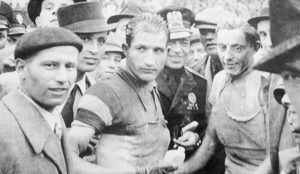
Did You Know?
Did you know we have set up a Pinterest site with a lot of interesting images. We hope you’ll visit the site often as Sandy is continuously updating it with new and interesting photographs. ![]()
Let’s Meet Gino Bartali
Gino Bartali (1914−2000) was born in Ponte a Ema, Florence, Italy into a poor farming family. Gino grew up to be a physically strong young man with a boxer’s face. He was a devout Catholic throughout his life and earned the nickname, “Gino the Pious.” At the age of thirteen, Gino got a job in a bicycle shop. Shortly afterwards, he began racing and quickly gained an excellent reputation as an amateur. At the age of twenty-one, Gino turned professional and the next year, he became the Italian champion by winning the Giro for the first time. Watch a memorial about Gino here.
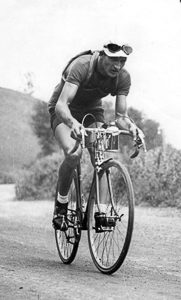
Gino married Adriana (1919−2014) in 1940 with the wedding officiated by Cardinal Elia Dalla Costa and blessed by Pope Pius XII. They had two sons, Andrea and Luigi. For the rest of their lives, the couple lived at Via Chiantigiana, 173, Florence. Gino retired from cycling at the age of 40. He passed away from a heart attack ten days after undergoing a heart bypass operation. He never told anyone about his wartime exploits, preferring to be known for his athleticism and cycling accomplishments.
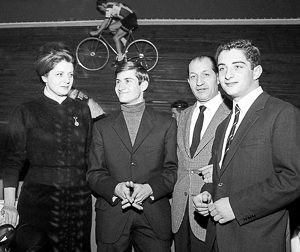
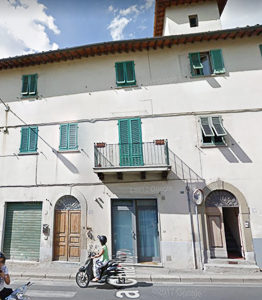
Mussolini and the Fascists
Italy was one of the three Axis powers, along with Japan and Germany, aligned against the Allies during World War II. Benito Mussolini (1883−1945) was the Prime Minister of Italy between 1922 and 1943. By 1925, Mussolini seized control of the government and became dictator and founded the Italian Fascist party. A totalitarian government was established and Mussolini began carrying out policies and agendas similar to the ones implemented by Hitler in 1933.
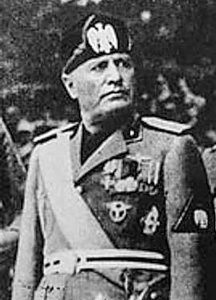
Italy entered World War II on the day France capitulated to the Nazis (10 June 1940). Mussolini knew he couldn’t beat the Allies alone but the appetite for land acquisition at the expense of France was too great. By 1943, Italy was suffering defeats in Russia, North Africa, and finally, the successful Allied invasion of Sicily. On 25 July 1943, Mussolini was removed as the head of the government and placed under arrest. He was rescued by Hitler and placed in charge of the puppet government in northern Italy.
On 3 September 1943, the Italian government signed an armistice with the Allies and from that time forward, the Allies could unload their troops and equipment on the docks. The Germans occupied northern Italy and by 9 September, Rome had been abandoned by the Italian politicians. Captured Italian soldiers were given the choice of fighting with the Wehrmacht or being deported as prisoners to Germany for forced labor. About 94,000 chose to continue fighting while 710,000 were sent to Germany. Approximately 60,000 men evaded capture and joined the resistance forces with Yugoslavia and Greece.
After the German invasion, Italian Jews were in jeopardy as the Nazis began their roundups and deportation of Jews to the extermination camps (Mussolini had protected the Jews). The Catholic church was instrumental in saving the lives of thousands of Jews. The Assisi Network, established by Catholic clergy, provided safe houses while the Archbishop of Florence, Elia Dalla Costa, organized resistance efforts as well as protecting Jews. After the invasion, Gino became involved with various resistance organizations and personally hid a Jewish family in his home.
Bicycle Training
Gino used Florence as his home base for training during the war. He would bike sometimes as far south as Rome, always wearing his famous racing jersey bearing his name. He was rarely stopped by the Germans or the Italian police as they knew the unpopular consequences of arresting him. Gino knew this and decided to leverage his status to assist in resistance efforts.
Cardinal Dalla Costa (1872−1961) was responsible for saving thousands of lives during World War II and the German occupation. He strongly encouraged his priests to hide Jews and he established shelters in monasteries and convents under his control. Cardinal Dalla Costa organized the production of fake documents in one of the Franciscan monasteries in Assisi. These were given to Jews to support their efforts in fleeing to safety. The documents would be personally delivered to Dalla Costa by representatives of the monastery. As the Nazis tightened their grip on occupied Italy, it became quite obvious that the fake documents had to find an alternate method of delivery. This is where Gino fit in.
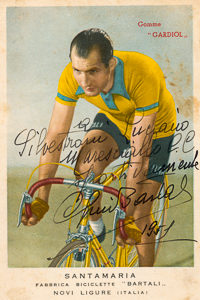
Gino was personally recruited by Dalla Costa. Gino would pretend he was in training when in fact, he was a courier for the resistance. The fake documents would be hidden in the hollow tubes of his bike’s handle bar and frame. Gino knew he wouldn’t be stopped or searched. If he was stopped, Gino would tell the police not to touch his bike as it was perfectly calibrated for performance.
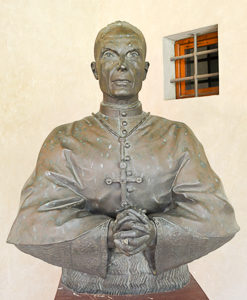
DELASEM and the Assisi Network
Two major Italian resistance organizations existed during the German occupation.
The Delegation for the Assistance of Jewish Emigrants or, DELASEM was a combined Italian and Jewish resistance group which existed between 1939 and 1947. Originally sanctioned by Mussolini, DELASEM was used to facilitate the emigration of refugees and foreigners. The group was legal up until the 1943 armistice when it went underground. Supported by the Catholic church as well as the Swiss government, DELASEM raised more than $1,200,000 to aid in sheltering, providing fake documentation, and transportation for Jews. The networks operated principally out of Rome, Florence, and Genoa with the support of Jews, police, priests, citizens, and Italian officials. One of DELASEM’s achievements was saving the orphanage children of Villa Emma at Nonantola from deportation to Auschwitz.
The other underground resistance organization was The Assisi Network.
This was established by Catholic clergy for the purpose of protecting Jews during the occupation. The St. Francis of Assisi Cathedral, churches, monasteries, and convents were used as safe havens. More than 300 lives were saved by the efforts senior church officials and others. Resistance members also assisted Jews with safe passage. The primary duties of the network included producing fake papers for transit purposes.
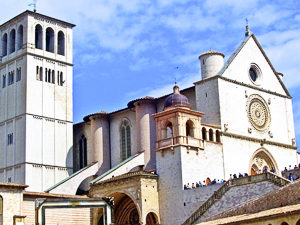
Gino was one of the couriers between DELASEM and the Assisi Network.
Campagna Concentration Camp
Mussolini established the Campagna concentration camp in 1940 for the purpose of detaining Jewish refugees, French and Italian Jews, and some British citizens. It was really an internment camp where the prisoners were treated well. By the time the Nazis reached the camp, the local citizens had released the inmates and they fled into the nearby mountains. Many of them were ultimately assisted by the Assisi Network.
Unfortunately, in October and November 1943, the Nazis rounded up and deported the Jews in Rome, Genoa, and Florence. Approximately 7,680 Italian Jews were murdered at Auschwitz during the Nazi occupation. It is estimated that 80% of the Jews living in Italy survived the war.
Giorgio Nissim and Gino
One of DELASEM’s leaders in Tuscany was Giorgio Nissim (1914−2000), a Jewish accountant. Nissim was a money courier as well as one of the printers of fake identification documents. His network was responsible for saving more than 800 Jews but it was discovered by the Nazis in the fall of 1943 and everyone except Nissim was sent to the extermination camps. Nissim passed away in 2000 and his sons discovered a diary in which their father outlined how Gino had risked his life to assist the various resistance networks. He wrote that Gino would leave Florence in the morning, ride to one of the convents where the Jews were hiding, collect their photographs, and ride back to Nissim who would use them to produce transit documents. Then Gino would collect the documents and ride back to the convent.
Even though the Nazis and Italian police did not bother Gino during his “training,” the SD (Nazi intelligence) did take Gino in for questioning one day in Florence. There he was subjected to threats on his life. His response was, “I do what I feel.” Released, Gino continued his work with the Assisi Network and during 1943, he led groups of Jewish refugees over the Swiss Alps.
Gino was responsible for saving the lives of his Jewish friend, Giacomo Goldenberg and his family. At the time, whenever the Nazis caught someone hiding Jews, they were immediately executed. That did not stop Gino from hiding his Jewish friends in the cellar of his home until Florence was liberated in 1944.
A Hero
After the war, Gino was like most—he never talked about the war or his role. When his son, Andrea, finally got him to discuss it, Gino refused to view his actions as heroic. He told Andrea, “One does these things and then that’s that.” He made Andrea promise never to discuss it with anyone. Andrea wanted to know why and his father said, “You must do good, but you must not talk about it. If you talk about it, you’re taking advantage of others’ misfortunes for your own gain.”
When people would say he was a hero, Gino replied, “I’m just a cyclist.”
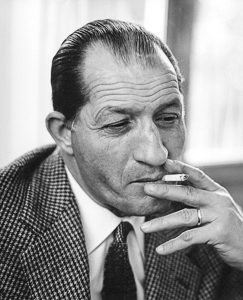
Righteous Among The Nations
Thirteen years after Gino’s death, Yad Vashem recognized the cyclist’s efforts to save Italian Jews during the German occupation. He was recognized as “Righteous Among the Nations.” Cardinal Elia Dalla Costa received the same honor one year before Gino. Many of the leading members of DELASEM and the Assisi Network, including Giorgio Nissim, have also been recognized by Yad Vashem. Watch a video about the Assisi Network recognition here.
Watch a video on Gino Bartali being recognized as “Righteous Among the Nations” here and by the Holocaust museum here.
Recommended Reading and Viewing
McConnon, Aili and Andres. Road to Valor. New York City: Broadway Books, 2013.
Jacoby, Oren (Producer/Director). My Italian Secret: The Forgotten Heroes. Storyville Films, 2014.
Globus, Yoram and Menahem Golan (Producers). The Assisi Underground. MGM, 1985. Watch the movie trailer here.
What’s New With Sandy and Stew?
We’ve finally moved into our new home. It was well worth the wait, even after a two-and-a-half-month delay. We only had two weeks from the time we moved in to the time we had to travel to England for our cruise around the British Isles. We busted our rear ends during those two weeks and got about eighty percent settled in. Now, it’s pretty much life back to normal—except for the numerous trips to Goodwill and the consignment shops. I suppose our next road trip is to swing by and drop off a bunch of stuff to our kids in California and Iowa.
Someone Is Commenting On Our Blogs
Paul M. contacted me a while ago to let me know he was a British military historian with a specialization in SOE history. Paul has written four or five books which have been very well received. Link to Paul’s books here. He recently accompanied a group of friends to Paris for the purpose of attending annual memorial services at Mont Valérien for the annual memorial services. Paul was gracious to ask me if he could reprint some of my blogs to share with his friends. I told him, “Absolutely!”. It was also very kind of him to mention he would promote my books as well. Several of the planned stops have to do with the Bonny-Lafont gang. (Read The French Gestapo here.)
I’ve asked Paul if he would write a guest blog and I think we’ll see one in the near future.
If there is a topic you’d like to see a blog written about, please don’t hesitate to contact me. I love hearing from you so keep those comments coming.
Why Would You Want To Buy Our “Walks Through History” Books?
Simple.
You like to travel and experience history and historical events. You like to see original buildings that had a significant impact on the people and events of the history you’re engaged with. You want to know the stories behind the brick and mortar in front of you.
The walking tour books are meticulously researched so you can go directly to those sites and learn about the building’s history as well as an introduction to some of the more interesting people associated with it.
Thank You
Sandy and I appreciate you visiting with us. We have some exciting things on the horizon and we’ll keep you updated as we go along.
Share This:
Follow Stew:
Find Stew’s books on Amazon and iBooks.
Please note that we do not and will not take compensation from individuals or companies mentioned or promoted in the blogs.
Walks Through History
Copyright © 2018 Stew Ross



I have read your article about Gino Bartali with great interest. I’d like you to know that I have written the first book about this inspiring hero for young people, ages 8-12, entitled: The Brave Cyclist: The True Story of a Holocaust Hero. It launches on August 1st , 2019 by Capstone Publishing.
Here’s a link to the book trailer if you’d like to watch: https://youtu.be/id5FXD33EvA
Hi Amalia;
Thanks for reaching out to us. First of all, congratulations on your new book. It looks great and I think you found a wonderful illustrator. I read parts of it and really enjoyed it. We need more books like yours for the children to read. They aren’t being taught this history any longer. I hope you’ll have time to go through my blogs and hopefully, you’ll find a topic that might inspire your next children’s book. If there are other stories you might think are worthy of a blog, let me know. STEW